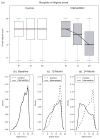HIV prevention intervention to reduce HIV-related stigma: evidence from China
- PMID: 19926963
- PMCID: PMC2939905
- DOI: 10.1097/QAD.0b013e3283313e83
HIV prevention intervention to reduce HIV-related stigma: evidence from China
Abstract
Background: The National Institute of Mental Health Collaborative HIV/Sexually Transmitted Disease Prevention Trial provided a unique opportunity to test whether, with the community-based diffusion of HIV/sexually transmitted disease prevention information and an elevated understanding of HIV, the level of stigmatizing attitudes toward people living with HIV/AIDS in the community would be reduced.
Method: A total of 4510 market workers in Fuzhou, China, participated in the study, and longitudinal analyses included study samples of 3785 participants in the 12-month follow-up and 3716 participants in the 24-month follow-up. We graphically examined the change in HIV-related stigma indicators over time between control and intervention groups using boxplot and kernel density estimation. A logistic regression analysis with proportional odds model was further used to examine the intervention effect on HIV-related stigmatizing attitudes.
Results: Compared with no change over time for the control group, the intervention successfully reduced the level of HIV-related stigmatizing attitudes among the target population at the 12-month follow-up, and the effect increased by two-fold (with respect to odds ratios) at the 24-month follow-up.
Discussion: The intervention demonstrated positive attitude changes associated with HIV-related stigma. Our results show the importance of social norms, rather than simply individual behaviors, in developing and implementing stigma reduction campaigns.
Figures

References
-
- Herek GM, Capitanio JP. AIDS stigma and sexual prejudice. Am Behav Sci. 1999;42:1126–1143.
-
- Malcolm A, Aggleton P, Bronfman M, Galvao J, Mane P, Verrall J. HIV-related stigmatization and discrimination: its forms and contexts. Crit Public Health. 1998;8:347–370.
-
- UNAIDS. Fact sheet on stigma and discrimination. Dec2003. [Accessed 2 February 2009]. http://data.unaids.org/Publications/Fact-sheets03/fs_stigma_discriminati....
Publication types
MeSH terms
Grants and funding
LinkOut - more resources
Full Text Sources
Medical

